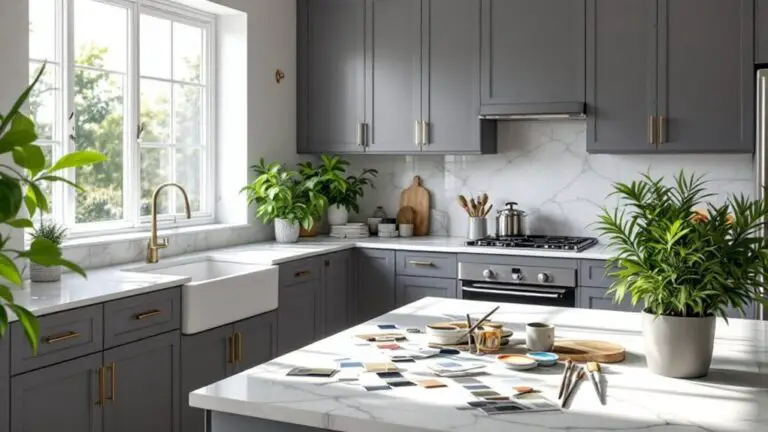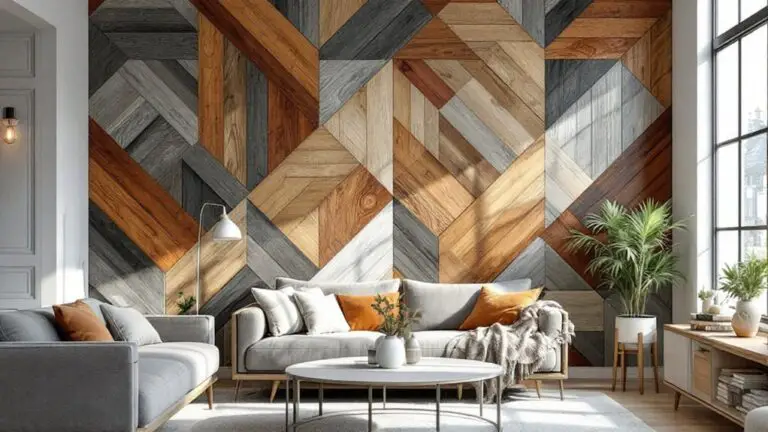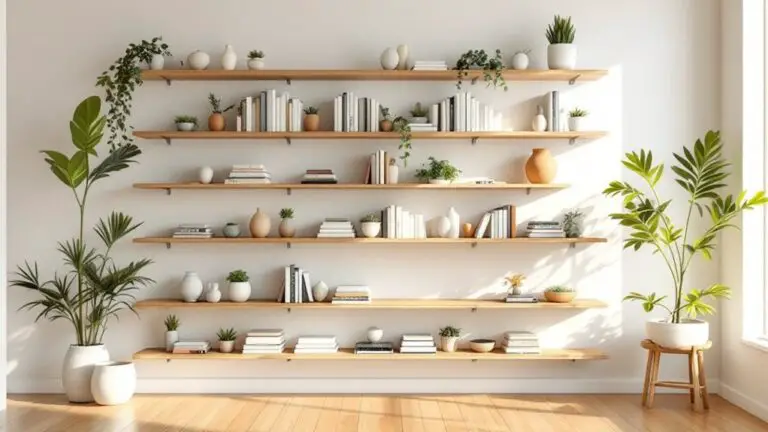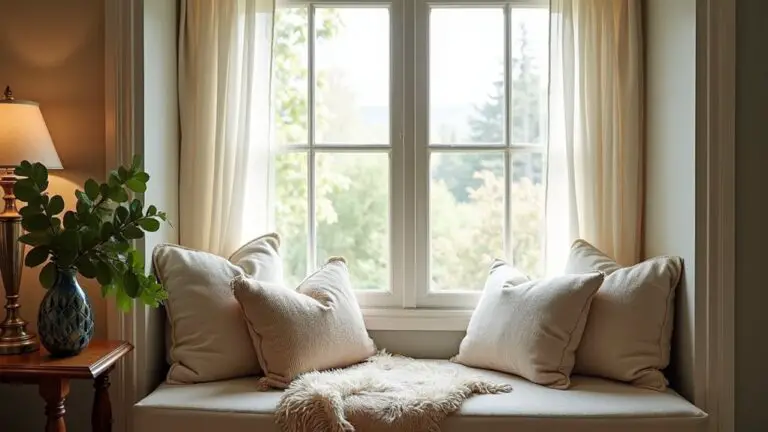What Is Japandi?

You might not know that Japandi, a design style that has been gaining traction, is a unique blend of Japanese minimalism and Scandinavian coziness. This aesthetic, rooted in the principles of ‘wabi-sabi’ and ‘hygge,’ combines the Japanese appreciation for imperfection and transience with the Scandinavian emphasis on comfort and simplicity. Characterized by clean lines, neutral color palettes, and a focus on natural materials like wood and stone, Japandi creates serene and functional spaces. As you explore this style further, you’ll discover how it promotes a sense of tranquility and intentional living, making it an intriguing choice for those seeking a harmonious and sustainable home environment.
Definition of Japandi Style

Japandi style is a design philosophy that seamlessly merges the simplicity and elegance of Japanese minimalism with the cozy, warm essence of Scandinavian design. This hybrid aesthetic is all about embracing the principle of minimalism, where every item in your space serves a purpose and function. You’ll focus on simplicity and reduce clutter, using minimal decorative accents to avoid visual noise and creating free-flowing open zones by eliminating non-essential objects. Negative space is vital, as it helps to evoke tranquil mindstates and allows the eye to relax.
Natural elements are integral to Japandi design. You’ll rely heavily on natural organic materials like wood, stone, and rattan, and incorporate natural wood finishes such as oak or walnut for flooring and furniture. Breathable natural fibers like linen, cotton, and wool are ideal for textiles, while handmade ceramics and earthenware add grounding tones.
The color palette is neutral and inspired by nature, featuring warm neutrals like beige and tan alongside cooler tones like gray and blue. Natural light is essential, with large windows and open layouts inviting light into your home. This emphasis on natural light serves as a bridge to nature, enhancing the connection between the indoor space and the natural world. Sustainability is also a core principle, emphasizing high-quality, natural materials and unique, handmade pieces that guarantee each interior is distinct and environmentally friendly. This approach creates a harmonious balance between indoors and outdoors, fostering a sense of tranquility and calm.
Historical Context and Origins
The cultural exchange between Japan and Western countries, particularly Denmark, laid the groundwork for the Japandi design style. This exchange began in the 19th century when Japan opened its borders after over 200 years of isolation under the Sakoku policy. This marked the beginning of significant cultural exchanges with Western countries.
As Japan’s borders opened, Danish designers and artists traveled to the country, where they were deeply influenced by Japanese aesthetics, especially the concept of wabi-sabi. One key figure was William Carstensen, a Danish naval lieutenant who published a book titled “Japan’s Capital and the Japanese” in the 1860s. This book highlighted the parallels between Japanese wabi-sabi and Danish hygge, both of which celebrate minimalism, natural materials, and simplicity.
Early manifestations of Japandi design can be seen in ceramic craftsmanship, architectural elements, and Danish furniture. The historical interaction between Denmark and Japan, spanning approximately 150 years, has been essential in shaping this design style. Nicolina Olsen-Rule of Design Museum Denmark notes that this enduring connection has contributed to the mutual appreciation and influence observed in design. This fusion of Japanese and Scandinavian design philosophies has resulted in a unique and timeless style that continues to evolve, emphasizing minimalism, ergonomics, and natural materials. The design also incorporates the principle of Less is More, which is prevalent in Japandi aesthetics.
Core Philosophy and Influences

At the heart of Japandi design lies a robust core philosophy that melds the best of Japanese and Scandinavian influences. This hybrid aesthetic is rooted in several key philosophical foundations. Wabi-sabi finds beauty in imperfection and impermanence, appreciating the authenticity of natural materials, while hygge emphasizes comfort and coziness, focusing on warmth and well-being through soft lighting and cozy textiles. Minimalism plays a significant role, emphasizing simplicity by reducing clutter and distractions to focus on essentials.
The design also highlights a deep connection to nature, incorporating natural materials like wood, stone, and plant life to bring warmth and texture to the space. The principle of imperfection is celebrated through wabi-sabi’s appreciation of aged surfaces and the beauty of impermanence. Simplification reduces unnecessary elements to create a calming and minimalist space, ensuring each element serves a purpose and enhances overall balance and harmony.
Japandi design integrates Scandinavian simplicity with clean lines, neutral color palettes, and uncluttered spaces, along with Japanese aesthetics such as low-to-the-ground furniture and natural materials. It values quality craftsmanship and sustainability, ensuring timeless and durable design. By blending these influences, Japandi creates a unique, serene, and inviting living environment that prioritizes mindfulness, comfort, and authenticity. This approach also emphasizes the importance of smart storage solutions, ensuring that each design piece serves a practical function while maintaining the aesthetic of the space.
Key Elements of Japandi Design
In the pursuit of a serene and inviting living space, the key elements of Japandi design come into play, blending simplicity, functionality, and a deep connection to nature.
Clean Lines and Minimalism are at the heart of Japandi. You’ll focus on simplicity and functionality, creating uncluttered spaces with minimal ornamentation. Low-to-the-ground furniture, inspired by Japanese traditions, and the incorporation of natural light through large windows and sliding doors are vital. This design integrates indoor and outdoor spaces for a seamless flow, enhancing the sense of openness and calm.
Natural Light and Ventilation are essential. Large windows, sliding doors, skylights, and clerestory windows guarantee ample natural light. Mirrors and reflective surfaces help distribute light evenly, while open floor plans facilitate airflow and light circulation. Strategically placing plants optimizes light usage, creating a harmonious and well-lit environment.
Furniture and Decor emphasize lightweight, natural materials like wood and bamboo. Traditional Scandinavian and Japanese craftsmanship are highlighted, with a focus on durability and sustainability. Minimalist decorative elements, such as simple textiles and ceramics, are integrated, and natural fabrics and organic materials are used for upholstery and rugs.
The Color Palette is dominated by neutral tones like whites, greys, and beiges, with earthy tones and deep greens adding depth. Charcoal grey provides contrast, while warm shades like golden straw add coziness, creating a tranquil and peaceful atmosphere.
Design Materials and Textiles
As you create a serene and inviting Japandi space, the choice of design materials and textiles plays a significant role in maintaining the balance between simplicity and natural beauty.
Natural materials are at the heart of Japandi design. Wood, for instance, is a primary material, offering varied textures and unique patterns. Hardwoods like oak, beech, and mahogany, as well as softwoods such as pine, redwood, and fir, are commonly used for furniture and decor. Natural stone adds depth and grounding with its diverse textures and patterns, while metals with a patina finish, like brass and copper, bring sophistication and character through their aging process.
For textiles, Japandi design often incorporates linen, a natural fiber used for curtains, pillows, and tablecloths, adding elegance and sophistication. Organic cotton, wool, and hemp are also favored for their sustainability and eco-friendliness. These materials are used in various forms, from upholstery to fabrics, enhancing the cozy and comfortable atmosphere of the space.
The use of sustainable materials such as reclaimed wood, bamboo, and cork further aligns with the Japandi ethos of reducing waste and promoting eco-friendly design. Natural fiber textures and minimalist fabric patterns, including neutral color palettes and subdued patterns, are key to maintaining the serene and harmonious environment that Japandi design aims to achieve. This approach also emphasizes minimalism, ensuring that the space remains uncluttered and visually appealing.
The incorporation of these materials and textiles helps in creating a space that is not only visually appealing but also promotes a sense of well-being and connection to the natural world.
Decorating Principles and Techniques
To create a Japandi space that exudes serenity and inviting warmth, you need to adhere to several key decorating principles and techniques. At the heart of Japandi design is a neutral color palette, which incorporates whites, grays, beiges, and blacks to create a calming backdrop. This palette sets the stage for other design elements to shine.
Key Decorating Principles
- Emphasis on Natural Materials: Use wood, bamboo, stone, and linen for furniture, flooring, textiles, and accessories to foster a connection with nature.
- Minimalist Aesthetic: Focus on simplicity and reduce clutter to maintain a clean and uncluttered space.
- Functional Furniture: Select furniture that is both practical and aesthetically pleasing, guaranteeing each piece serves a purpose.
- Negative Space: Utilize empty or unoccupied areas to create a sense of openness and balance.
Incorporating these principles, you can achieve a harmonious and timeless design. For instance, using natural materials like wood and stone adds warmth, while functional furniture guarantees the space remains practical. The minimalist aesthetic and use of negative space enhance the sense of openness and calmness, making your Japandi space both serene and inviting. By prioritizing durability and sustainability, you also guarantee your design stands the test of time. Additionally, incorporating elements like biophilic design helps to bring the outdoors in, enhancing the connection to nature and promoting tranquility.
Incorporating these principles, you can achieve a harmonious and timeless design. For instance, using natural materials like wood and stone adds warmth, while functional furniture guarantees the space remains practical. The minimalist aesthetic and use of negative space enhance the sense of openness and calmness, making your Japandi space both serene and inviting. By prioritizing durability and sustainability, you also guarantee your design stands the test of time. Additionally, incorporating elements like biophilic design helps to bring the outdoors in, enhancing the connection to nature and promoting tranquility.
Space Planning and Aesthetic Impact**
When designing a Japandi space, effective space planning is essential for creating an environment that is both aesthetically pleasing and highly functional. To achieve this, you should emphasize strategic furniture arrangement to enhance the overall aesthetic and functionality. Arrange furniture in a way that maintains clear pathways and promotes smooth traffic flow, ensuring the space feels intuitive and easy to navigate.
Prioritize simplicity and functionality in your furniture selection. Choose multifunctional pieces, such as storage ottomans and nesting tables, to maximize space and maintain a clutter-free environment. Low-profile furniture can create a sense of spaciousness and support a minimalist aesthetic.
Balance and harmony are vital in Japandi design. Balance light and dark elements to create a visually appealing space, and mix rich textures like wood, bamboo, and stone to add depth and visual interest. Use clean, simple lines to prevent visual clutter and incorporate natural elements to bring warmth and texture to the space. Solid colors over elaborate patterns help maintain simplicity and a peaceful atmosphere.
Incorporating natural materials such as wood, bamboo, and stone is also crucial, as these materials bring warmth, texture, and a connection to nature into the space.
Frequently Asked Questions
How Can I Incorporate Japandi Style Into a Small Apartment?
To incorporate Japandi style into a small apartment, optimize your furniture layout for ease of movement, use low-profile, multi-functional pieces, and incorporate natural materials like wood and plants. Utilize mirrors to reflect light, and add warmth with textiles like linen and wool. Keep the color palette neutral and emphasize natural light to create a bright, airy feel. Choose eco-friendly materials and embrace Wabi-Sabi aesthetics by appreciating simplicity and imperfection. Use rugs and open shelving to zone areas efficiently, maintaining a clutter-free and serene atmosphere.
Are There Specific Japandi Color Palettes for Different Rooms?
As you step into your serene Japandi sanctuary, each room can be a unique oasis. For bedrooms, opt for neutral tones with natural accents like oak and terracotta. Living rooms thrive with earthy browns and greens, or subtle blues and grays. In offices, muted monochromes in grays with warm undertones create focus, while children’s rooms can burst with creams and pastel pops. Balance light and dark tones to evoke a calming, innovative space.
Can Japandi Design Be Adapted for a Budget-Friendly Renovation?
You can adapt Japandi design for a budget-friendly renovation by using affordable natural materials like bamboo, pine, and rattan, opting for multi-functional furniture, and leveraging DIY projects and upcycling to maintain the minimalist and eco-friendly aesthetic.
How Do I Balance Minimalism With Personal Decor in a Japandi Space?
To balance minimalism with personal decor in a Japandi space, select a few meaningful, handmade, or unique items that align with the neutral color palette and natural materials. Add plants, simple accessories, and warm lighting to maintain the calm, cohesive aesthetic while injecting personal character. Choose items with intention to avoid clutter and guarantee each piece serves a purpose. This blend of minimalism and personal touches will create a harmonious and inviting space.
What Are Some Easy Ways to Add Japandi Elements to an Existing Decor?
To add Japandi elements to your existing decor, incorporate natural materials like wood and linen, use a neutral color palette with subtle textures, and opt for multi-functional, minimalist furniture. Add plants and subtle patterns through textiles or wallpaper. Choose high-quality, sustainable materials and utilize large windows for natural light.
Conclusion
As you embrace the Japandi style, you’re not just designing a space, you’re crafting a serene oasis. Imagine a tree growing naturally, its imperfections and scars telling a story of resilience. Similarly, Japandi design celebrates the beauty in imperfection through its use of natural materials and minimalist approach. This fusion of Japanese and Scandinavian aesthetics creates a tranquil environment that invites you to slow down and appreciate the simplicity and elegance of your surroundings.





